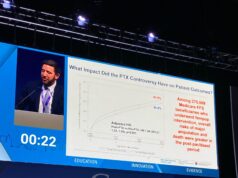
Peter Goverde who presented the Belgian registry results at EuroPCR 2013 in Paris, France (21–24 May), said that stenting of the superficial femoral artery with the biodegradable Remedy stent was safe and feasible.
Goverde, ZNA Hospital, Antwerp, Belgium, shared data and conclusions from the non-randomised, prospective, multicentre, observational registry titled REMEDY. The objective of the study was to evaluate the performance and safety of a biodegradable peripheral Remedy stent (Kyoto Medical), for the treatment of occluded or stenotic superficial femoral artery lesions.
“Currently, the treatment of in-stent restenosis remains a difficult and unresolved issue. We wanted to see if the placement of a “temporary” bio-absorbable stent can provide a solution [to this problem], as such stents disappear over time and can no longer induce intimal hyperplasia formation,” Goverde told delegates.
The biodegradable Remedy stent is made from poly-L-lactic acid, and its design is in the form of zig-zag helical coils. The strut thickness is 0.24mm and the stent is available in a variety of diameters (5mm, 6mm, 7mm and 8mm). It is available in two sizes 36mm and 78mm.
The investigators enrolled patients with documented symptomatic occlusion and/or 70% stenosis of the superficial femoral artery.
The lesions considered as suitable had to be able to be treated with a stent with a maximum length of 78mm, had to occur in vessels with a reference diameter between ≥4mm and ≤6mm. The lesions had to suitable for treatment with no more than one Remedy stent and had to be covered from healthy to healthy segments. The investigators also recommended predilatation.
Patients were excluded if they were pregnant; had previous bypass surgery or stenting in the target vessel; had a scheduled staged procedure of multiple lesions within the ipsilateral iliac or popliteal arteries within 30 days after the index procedure; had acute ischaemia; untreated inflow disease of the ipsilateral pelvic arteries (more than 50% stenosis or occusion); significant gastrointestinal bleeding or any coagulopathy that would contraindicate the use of antiplatelet therapy; and any known intolerance to study medications or contrast agents.
Goverde told delegates that 95 patients (mean age 67 years) were enrolled, of which 72% were male. Nearly 90% were smokers; nearly 70% suffered from hypertension; and approximately 65% had hypercholesteremia. Most lesions in the cohort (just under 90%) were classified Rutherford-Becker 2 or 3.
The investigators achieved technical success in 94.6% of cases. All patients were followed-up by use of ultrasound. At the six-month follow-up, primary patency was 70.9%, secondary patency was 88.9% and target lesion revascularisation was needed in 21.9% of cases. At the six-month mark, the majority of lesions were either Rutherford-Becker 0 or 1. Mean Rutherford-Becker lesion length at baseline was 2.96 and at the six-month mark, it was 0.76.
“These results have to be validated in larger trials including more complex lesions. Although biodegradable stents seem to be the ultimate candidate for the ideal stent, further evaluation is needed to understand their role as a substitute for bare metal or present generation metallic drug-eluting stents,” Goverde said.












